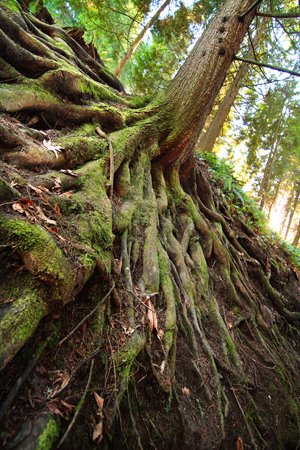I wondered how you would say goodbye to a tree…did they have names?
She (now peering from the eyeholes of an adult body) looked at me with incomprehension and laughing wonder, “No (of course not), they’re TREES.” She said as if that obviously explained it.
Even so, I got the impression that she talked to them and maybe felt the texture of their bark and reminisced of lazy summer days stretched out hammock-like in the junction of larger branches, or recklessly hid from the world of semi-evil adults, high in the leafy canopy.
Editor’s Note: Turns out she (the little girl who went to say goodbye to the trees) didn’t and doesn’t talk to trees. I’m guessing now that they merely shared quality time together in silent communion. It may also be possible that her imaginary friend Jennifer, who she did talk to, acted as an intermediary. So…umm…I was just kidding about that part I said about wanting to share occasional words with trees…really.

I don’t think I was ever on speaking terms with any trees, and now I wonder how I could have been so insensitive. If people can carry on dialogs with invisible gods, then it doesn’t seem too outlandish to share an occasional aside with a good supportive tree. I’m too skeptical to believe trees will answer, but perhaps like entering into prayer, merely talking to a tree will change the nature of the talker.
Perhaps the same religious/cultural influences that place humans at the apex of creation also desensitize us to the life around us, subtly forcing us to think of other races as inferior and the vegetable kingdom as merely things.
Back in the days when Pluto was a planet, and music was distributed on vinyl discs, the Portland Public Schools had something called Outdoor School. It was an opportunity for your whole sixth grade class to go ‘camping’ together out in the woods for a week and learn about nature.
All of the counselor/student teachers had adopted what were supposed to be Indian names. I can only remember Running Deer who was very pretty and very kind and who treated shy sixth grade boys as if they were handsome and articulate. The lesson she taught was about ‘The Web of Life’. She tried to explain how all life was connected. It is a simple thing to say, but to really appreciate it takes lifetimes of learning.
To realize that plants and animals all play the survival game with the same essential playbook, by shuffling the same four chemical building blocks, by passing DNA molecules from one generation to the next, is to understand that, amongst all the life on earth, we human beings are just one more novel answer to the same question, “How can we live?”
If plants and trees had not first learned how to feed on sunlight, we simply wouldn’t be here. To look at the canopy of a tree is to see an incredible architectural solution to how best make a solar array – an array that maximizes the collection of energy - that can be jettisoned during the winter so that the tree isn’t destroyed by the force of gale winds or the weight of ice and snow – a canopy that can store energy in life capsules which carry descendants into the future.

This work is in the public domain in the United States because it is a work of the United States Federal Government under the terms of Title 17, Chapter 1, Section 105 of the US Code.
To look at a tree canopy is to recognize strategies that life discovers to deal with the realities and limitations of the rules of the universe. The system of twigs and branches and trunks that distributes sap throughout the tree has its corollaries in the human circulatory system.
To see the sphere of a tree canopy, optimized for the collection of the sun’s food, is to recognize a similar strategy in the shape of the eye, optimized for gathering the sun’s light.

Somewhere inside me, I tried to dredge up that little boy – Running Deer’s devoted disciple (who first began to feel his place in the ‘web’) - as I climbed out of the heart of Portland into the West Hills toward the Hoyt Arboretum to meet with a variety of trees. http://www.hoytarboretum.org/

Naked trees with arms outstretched before a bright teasing sun – a sun that illuminates its dependents but withholds its warm embrace and nourishment.
Three variations on a theme:




Some trees decorated themselves in ribbons (It must have been some wild Christmas party!).

Some trees still carry the defenses they developed to keep dinosaurs from growing too familiar.













No comments:
Post a Comment